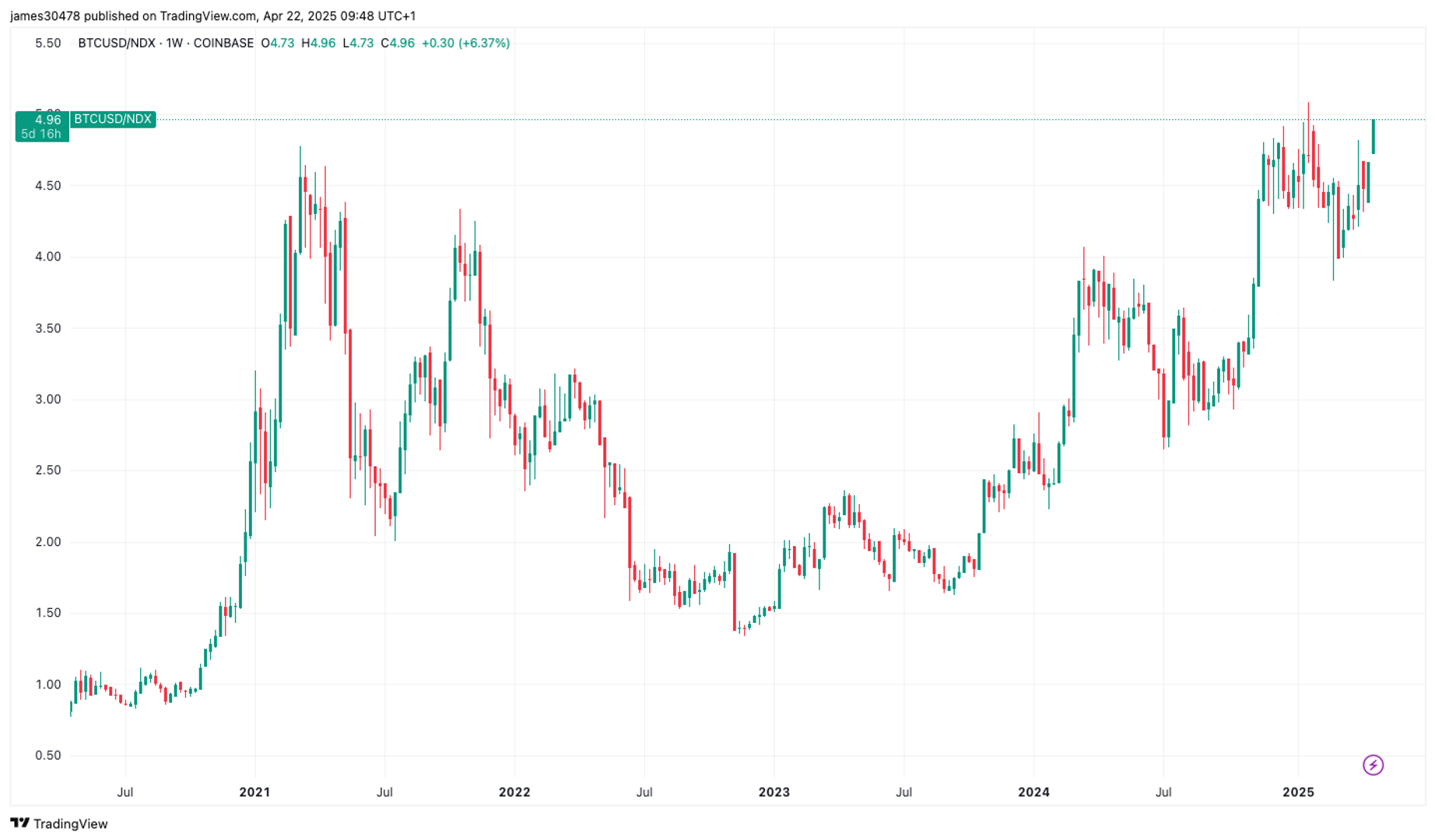Uncategorized
How Wall Street’s Relationship With Bitcoin Will Transform in 2025: 5 Predictions

When Michael Saylor announced MicroStrategy’s conversion of $250 million in Treasury reserves to bitcoin in August 2020, Wall Street analysts dismissed it as a reckless gamble. «Superior to cash,» Saylor declared of bitcoin at the time, drawing skepticism from traditional banking circles.
Yet today, those same banks that sneered at bitcoin’s corporate adoption are now scrambling to participate in bitcoin-collateralized lending as they race to capitalize on its superior characteristics as institutional-grade collateral and a thriving product-market fit.
Traditional collateral, such as real estate, requires manual appraisals, subjective valuations and complex legal frameworks that vary by jurisdiction. Bitcoin, by contrast, offers instant verification of collateral backing through public blockchain data, 24/7 real-time settlement and liquidation capabilities, uniform quality regardless of geography or counterparty, and the ability to enforce lending terms programmatically.
When a lender realizes that they can instantly verify and potentially liquidate bitcoin collateral at 3 a.m. on a Sunday — while real estate sits waiting for manual appraisals, subjective valuations, and potential evictions— there will be no going back.
1. Traditional banking bends the knee to bitcoin.
MicroStrategy’s (MSTR) approach fundamentally altered how public companies view bitcoin as a treasury asset. Rather than simply holding bitcoin, the firm has pioneered a treasury model of leveraging public markets to amplify its crypto position — issuing convertible notes and at the market equity offerings to finance purchases of bitcoin. This strategy has allowed MicroStrategy to significantly outperform spot bitcoin ETFs by harnessing the same financial engineering that made traditional banks powerful, but with bitcoin as the underlying asset instead of traditional financial instruments and real estate.
As a result, one of my predictions for 2025 is that MSTR will announce a 10-for-1 stock split to further its market share as it will allow many more investors to purchase shares and options contracts. MicroStrategy’s playbook demonstrates just how deeply bitcoin has penetrated traditional corporate finance.
I also believe financial services built around bitcoin are set to explode in popularity as long-term holders and new investors look to get more out of their positions. We expect to see rapid growth in bitcoin-collateralized loans and yield-generating products for bitcoin holders worldwide.
Moreover, there’s an almost poetic answer to why bitcoin-backed loans have become so popular — they are a true representation of financial inclusion, with a business owner in Medellín facing the same collateral requirements and interest rates as one in Madrid. Each person’s bitcoin carries identical properties, verification standards and liquidation processes. This standardization strips away the arbitrary risk premiums historically imposed on borrowers in emerging markets.
Traditional banks marketed «global reach» for decades while maintaining vastly different lending standards across regions. Now, bitcoin-backed lending exposes this inherited inefficiency for what it is: a relic of an antiquated financial system.
2. Borders fall as capital flows freely.
Nations are entering a new era of competition for bitcoin business and capital. Consequently, we expect to see new tax incentives specifically targeting bitcoin investors and businesses in 2025. These will happen alongside fast-track visa programs for crypto entrepreneurs and regulatory frameworks designed to attract bitcoin companies.
Nations historically competed for manufacturing bases or regional headquarters. Now they compete for bitcoin mining operations, trading venues and custody infrastructure.
El Salvador’s bitcoin treasury position represents early experimentation with nation-state bitcoin reserves. While experimental, their moves and the recent proposal for a U.S. Strategic Bitcoin Reserve forces traditional financial centers to confront bitcoin’s role in sovereign finance.
Other nations will study and attempt to replicate these frameworks, preparing their own initiatives to attract bitcoin-denominated capital flows.
3. Banks race against obsolescence.
In debt markets, necessity drives innovation. Public companies now routinely tap bond markets and convertible notes to finance bitcoin-related transactions. The practice has transformed bitcoin from a speculative asset into a cornerstone of corporate treasury management.
Companies like Marathon Digital Holdings and Semler Scientific have been successful in following MicroStrategy’s lead, and the market has rewarded them. This is the most important signal for treasury managers and CEOs. Bitcoin’s got their attention now.
Meanwhile, bitcoin lending markets have come a long way over the last two years. With the deadwood being cleared away, serious institutional lenders now demand proper collateral segregation, transparent custody arrangements and conservative loan-to-value ratios. This standardization of risk management practices attracts precisely the type of institutional capital that previously sat on the sidelines.
More regulatory clarity out of the U.S. should open the door for more banks to get involved in bitcoin financial products — this will benefit consumers the most, with new capital and competition driving rates down and making bitcoin-backed loans even more compelling.
4. Bitcoin and crypto M&A intensifies.
As regulatory clarity emerges through the SAB 121 resolution addressing crypto custody and other guidance, banks will face a critical choice: build or buy their way into the growing market of bitcoin & lending. As a result, we predict at least one of the top 20 U.S. banks will acquire a crypto business in the coming year.
Banks will want to move fast, and development timelines for cryptocurrency infrastructure stretch beyond competitive windows, while established firms already process billions in monthly volume through battle-tested systems.
These operational platforms represent years of specialized development that banks cannot rapidly replicate. The acquisition premium shrinks against the opportunity cost of delayed market entry.
The confluence of operational maturity, regulatory clarity and strategic necessity creates natural conditions for the banking industry’s acquisition of cryptocurrency capabilities.These moves mirror previous financial technology integration patterns in which banks historically acquired electronic trading platforms rather than building internal capabilities.
5. Public markets validate bitcoin infrastructure.
The cryptocurrency industry is poised for a breakthrough year in public markets. We expect to see at least one high-profile crypto initial public offering exceeding $10 billion in valuation in the U.S. Major digital asset companies have built sophisticated institutional service layers with revenue streams that now mirror those of traditional banks, processing billions in daily transactions, managing substantial custody operations with rigorous compliance frameworks and generating stable fee income from regulated activities.
The next chapter of finance will therefore be written not by those who resist this change but by those who recognize that their very survival depends on embracing it.
Uncategorized
Bitcoin Closing In on Historic Breakout vs Nasdaq

Bitcoin (BTC) is on the cusp of breaking out relative to the Nasdaq 100 Composite, with the current BTC/Nasdaq ratio sitting at 4.96. This means it now takes nearly five Nasdaq units to match the value of one bitcoin. The previous record of 5.08 was set in January 2025, when bitcoin hit its all-time high of over $109,000.
Historically, each market cycle has seen the ratio reach new highs—2017, 2021, and now 2025—highlighting bitcoin’s continued outperformance against the Nasdaq.
Across multiple timeframes, bitcoin is increasingly diverging from U.S. tech stocks. Year-to-date, bitcoin is down just 6%, compared to the Nasdaq’s 15% decline. Since Donald Trump’s election victory in November 2024, bitcoin has rallied 30%, while the Nasdaq has fallen 12%.
When measured against the «Magnificent Seven» mega-cap tech stocks, bitcoin remains around 20% below its all-time high from February this year. This indicates that while bitcoin has shown strength, the top tech names are holding up better than the broader Nasdaq Composite.
Strategy (MSTR), a well-known proxy for bitcoin exposure, is also holding up better than the U.S tech stocks. Since joining the QQQ ETF on Dec. 23, MSTR is down 11%, while the ETF itself has dropped over 16%. The divergence has become more pronounced in 2025: MSTR is up 6% year-to-date, compared to QQQ’s 15% decline.
Uncategorized
Bitcoin Runs Into Resistance Cluster Above $88K. What Next?

This is a daily technical analysis by CoinDesk analyst and Chartered Market Technician Omkar Godbole.
Bitcoin’s (BTC) bullish advance has encountered a resistance zone above $88,000, marked by crucial levels that could make or break the ongoing recovery rally.
The resistance cluster’s first and perhaps most critical level is the 200-day simple moving average (SMA) at $88,356. The SMA is widely regarded as a key indicator of long-term momentum. Early this month, Coinbase institutional analysts called the downside break of the 200-day SMA in March a sign of the onset of a potential crypto winter.
So, a fresh move above the 200-day SMA could be taken to represent a renewed bullish shift in momentum.
Such a move would trigger a dual breakout, as the Ichimoku cloud’s upper end is located close to the 200-day SMA. A move above the Ichimoku cloud is also said to reflect a bullish shift in momentum.
Developed by a Japanese journalist in the 1960s, the Ichimoku cloud is a technical analysis indicator that offers a comprehensive view of market momentum, support, and resistance levels. The indicator comprises five lines: Leading Span A, Leading Span B, Conversion Line or Tenkan-Sen (T), Base Line or Kijun-Sen (K) and a lagging closing price line. The difference between Leading Span A and B forms the Ichimoku Cloud.
The third and final level forming the resistance cluster is the high of $88,804 on March 24, from where the market turned lower and fell back to $75,000.

A make-or-break resistance zone?
Behavioural aspects of trading come into play when an asset approaches a resistance zone, especially at key levels like the 200-day SMA and the Ichimoku cloud.
Prospect theory suggests that people are typically risk-averse with respect to gains and risk-seeking with respect to losses, known as the “reflection effect.» So, as traders, people tend to be risk-averse while locking in profits and keep losing trades open.
This tendency is amplified when an asset encounters a significant resistance zone. Traders who entered the bitcoin market around $75K, anticipating a rebound, may feel pressured to take profits as the price approaches this resistance. Such selling could, in turn, slow the price ascent or even trigger a new downturn.
Conversely, if bitcoin successfully breaks through the resistance zone, the fear of missing out could prompt more traders to make bullish bets, further fueling bullish momentum and pushing the price higher.
Uncategorized
Bithumb to Split in Two as Crypto Exchange Inches Toward South Korean IPO

Bithumb plans to split its core crypto exchange business from other activities as it reorganizes in preparation for an initial public offering (IPO).
The Seoul-based company will split in two, with Bithumb Korea focusing solely on operating the core crypto exchange business. Bithumb Korea will be the entity seeking a public listing, local media reported, citing the country’s corporate registry.
The other unit, a newly created company called Bithumb A, will oversee venture investments, asset management and new business initiatives. The restructuring is set to take effect on July 31.
Bithumb A will consolidate the exchange’s investment arms, including Bithumb Partners, which has shifted from NFT and metaverse projects to financial product investments such as equities, bonds and convertible bonds. According to local media, Bithumb is in talks with licensed entities to offer these services in the country.
Bithumb Investment, which manages equity stakes and strategic partnerships with external companies, will also fall under Bithumb A’s oversight.
Last year Bithumb was said to be considering a NASDAQ listing, but now its plans have shifted to a listing on South Korea’s Kosdaq first, with a U.S. listing as a secondary objective.
Bithumb posted an operating profit of 130.8 billion won ($95 million) in 2024, reversing a 149 billion-won loss from the previous year, local media reported.
-

 Fashion6 месяцев ago
Fashion6 месяцев agoThese \’90s fashion trends are making a comeback in 2017
-

 Entertainment6 месяцев ago
Entertainment6 месяцев agoThe final 6 \’Game of Thrones\’ episodes might feel like a full season
-

 Fashion6 месяцев ago
Fashion6 месяцев agoAccording to Dior Couture, this taboo fashion accessory is back
-

 Entertainment6 месяцев ago
Entertainment6 месяцев agoThe old and New Edition cast comes together to perform
-

 Sports6 месяцев ago
Sports6 месяцев agoPhillies\’ Aaron Altherr makes mind-boggling barehanded play
-

 Business6 месяцев ago
Business6 месяцев agoUber and Lyft are finally available in all of New York State
-

 Entertainment6 месяцев ago
Entertainment6 месяцев agoDisney\’s live-action Aladdin finally finds its stars
-

 Sports6 месяцев ago
Sports6 месяцев agoSteph Curry finally got the contract he deserves from the Warriors





